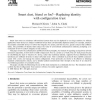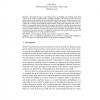1291 search results - page 231 / 259 » Intrusion Detection for Distributed Applications |
CN
2004
13 years 8 months ago
2004
Smart dust motes are miniature self-contained systems that may be deployed in very large numbers. In military applications these devices are subject to different threats than conv...
PE
2007
Springer
13 years 8 months ago
2007
Springer
Multicast-based inference has been proposed as a method of estimating average loss rates of internal network links, using end-to-end loss measurements of probes sent over a multic...
ICWS
2010
IEEE
13 years 7 months ago
2010
IEEE
Abstract—Recently, mashups are gaining tremendous popularity as an important Web 2.0 application. Mashups provide end-users with an opportunity to create personalized Web service...
JUCS
2010
13 years 7 months ago
2010
: This paper presents an agent-based system for building and operating agent-based context-aware services in public spaces, including museums. The system provides users with agents...
WCRE
2010
IEEE
13 years 7 months ago
2010
IEEE
—An important application of binary-level reverse engineering is in reconstructing the internal logic of computer malware. Most malware code is distributed in encrypted (or “pa...


